The Cane Corso breed (a type of Italian Mastiff) has done very well for itself in the U.S. considering it was almost extinct sixty years ago! Only a handful of specimens survived, and these were cared for by breed fanciers who used them as a foundation for all future Cane Corso dogs.
In the 1970s and 1980s, the Cane Corso was revived as a breed, reaching American shores by 1988. It was only recognized by the American Kennel Club (AKC) in 2010, but since then, it has risen in the most popular breed ranking, reaching #32 of 202 purebred dog breeds!
Most photos of Cane Corsi will show a large, solid black dog with piercing eyes. They are generally calm and placid, but have an expression of supreme confidence that says, go on, just try it…
Aside from these big black beasts, these dogs are available in different colors, including the one in our title: the formentino Cane Corso. This unusual color may be unfamiliar to many readers, so we’re here to enlighten you.
Join us as we look into the world of Cane Corso colors, find out what formentino means, and discover more about these majestic dogs.
What Is A Formentino Cane Corso?
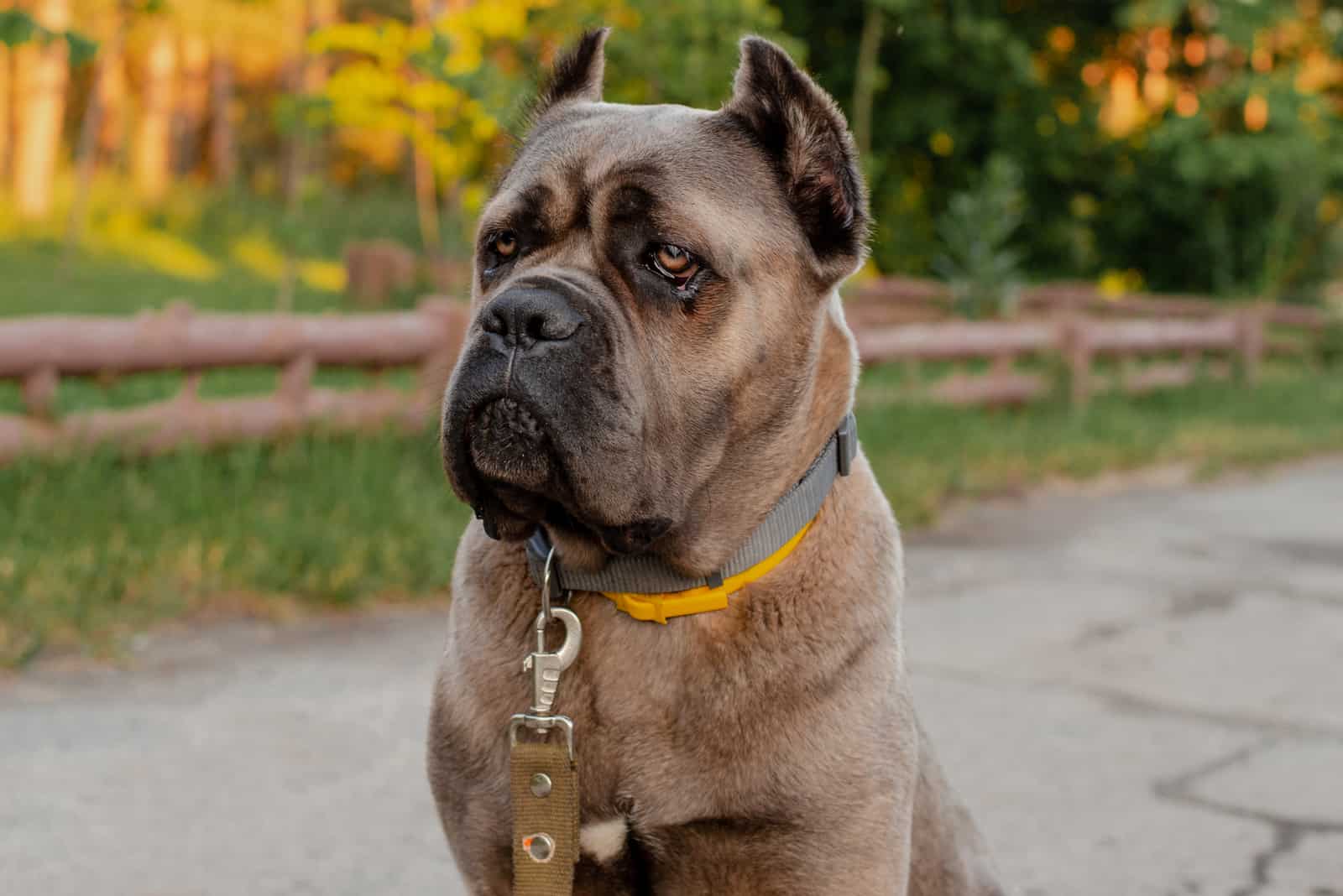
The word “formentino” means fermented wheat in Italian, and this describes this dog’s unique coat color.
In reality, it is a washed-out fawn (also known as carbon-colored) color with a gray/blue nose and mask. They also often have clear-colored or very light blue eyes, giving them a striking appearance.
In fact, they look so different from other Cane Corsos that some breeders have been known to try to pass them off as an entirely separate breed!
As this is a diluted color produced by a recessive gene (see the section below on coat colors), there is an increased risk of skin conditions. Some experts also believe that the formentino Cane Corso has a shorter lifespan, with an average of around 8 years.
In all other respects, they are exactly the same as Cane Corsi in standard colors.
Light-colored Cane Corsi were highly valued in Italy at one time. They were known as straw stack dogs as they had similar coloring to the straw stacks they guarded. These stacks provided food for humans and animals as well as raw materials for crafts.
At times, they also provided shelter for livestock. Farmers had to know that they could trust their loyal Cane Corso to guard the animals and the stacks as this was their livelihood and means of survival.
These days, the formentino (and other lighter colors) are rare, and emphasis is placed on breeding black or darker-colored dogs. Some light coat colors are regarded as faults, or seen as the result of crossbreeding in the past, even though they occur naturally in purebred Cane Corso litters from time to time.
Are Cane Corso Banned?
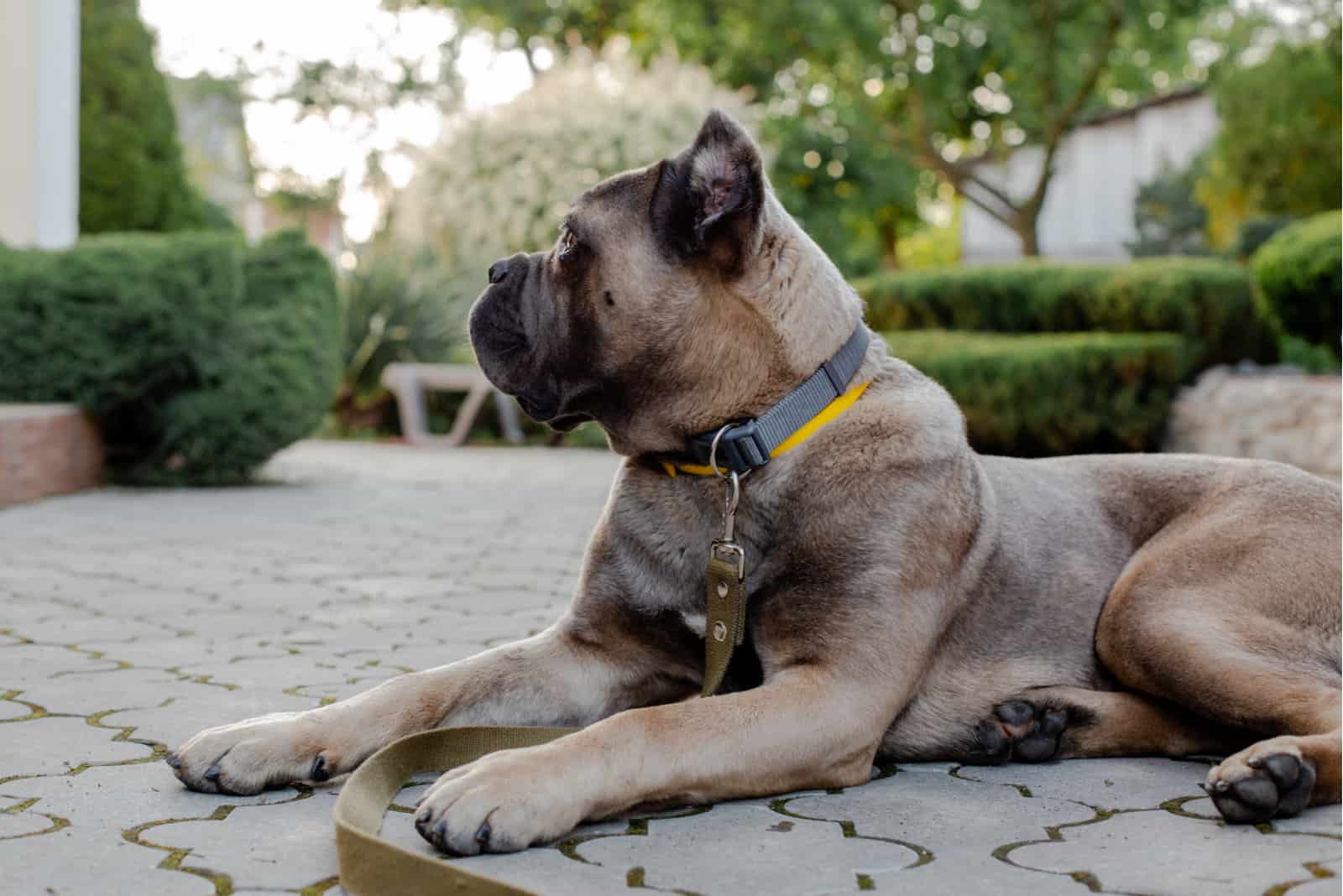
In some areas, sadly, they are. They are banned or restricted in some states and cities across America, including South Dakota, Washington, Nebraska, Kansas, Idaho, Colorado, Arkansas, and Oregon.
It is wise to check local legislation before buying rather than find yourself on the wrong side of the law once you get your puppy. If you live on the fringes of any of these states, be very careful about where you travel!
Some states have laws in place that prohibit breed-specific legislation (BSL), meaning that no new law can be passed to ban a dog based on its breed or its similarity to a banned breed. BSL is often passed based on a small amount of data connected with dog bites, and the Cane Corso is affected by this because of its powerful bite.
These statistics are, in a way, meaningless*. Of course, for the people who have gone through the horror of being bitten, mauled, or even killed by these massive dogs, it’s a very real thing. Likewise, for the loved ones left to deal with the loss.
However, Cane Corsi only account for a very small minority of attacks on humans each year. In many cases, this comes down to human error, ignorance, and lack of common sense.
Most of these incidents can be avoided by educating ourselves on how to handle large dogs, how to keep our yards and gardens secure, teaching kids how to behave around dogs, and never leaving children and dogs unsupervised.
It also makes a difference where you buy your dog. Respected and reputable breeders aim to produce dogs with a stable temperament, and most will begin training and socialization within a few days of the pups being born.
It’s up to you to continue the process, ensuring that your dog always obeys your commands rather than allowing its instincts to take over.
*For example, PitBull type dogs were believed to be responsible for 284 deaths since 2016. The Rottweiler was second, with 45 deaths. The Cane Corso doesn’t appear as a separate breed, but is included with the Mastiff/Bullmastiff group, which was responsible for 14 deaths. American Bulldogs were responsible for 15 deaths. PitBulls and Cane Corsos are restricted or banned, but the Rottweiler and the Bulldog aren’t!
Formentino Cane Corso: Price
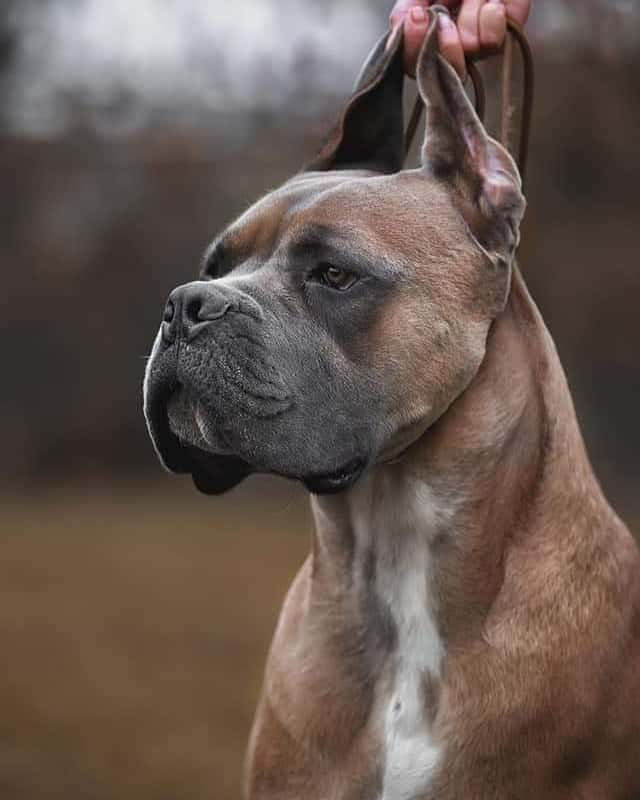
Photo from: @dracaryskingdom
A healthy, pet-quality Cane Corso will generally cost between $1,000 and $2,000 from a reputable breeder.
For a show-quality dog, you are looking at between at least $2,500 and $4,000, and possibly as much as $8,000 depending on the breeder and the pedigree of your puppy.
As for a formentino Cane Corso, the price shouldn’t be too much higher than a black one, even though it is quite a rare color. Reputable breeders will never breed for color; only for health, temperament, and form.
They may have an idea of what color the pups will be, but it is not an exact science. You should be suspicious of any breeder who advertises puppies as ‘rare colors’, especially if they charge a lot more for them.
If anything, the formentino Cane Corso should be cheaper as it does not conform to the breed standard and potentially has a shorter lifespan.
Formentino Cane Corso Puppies
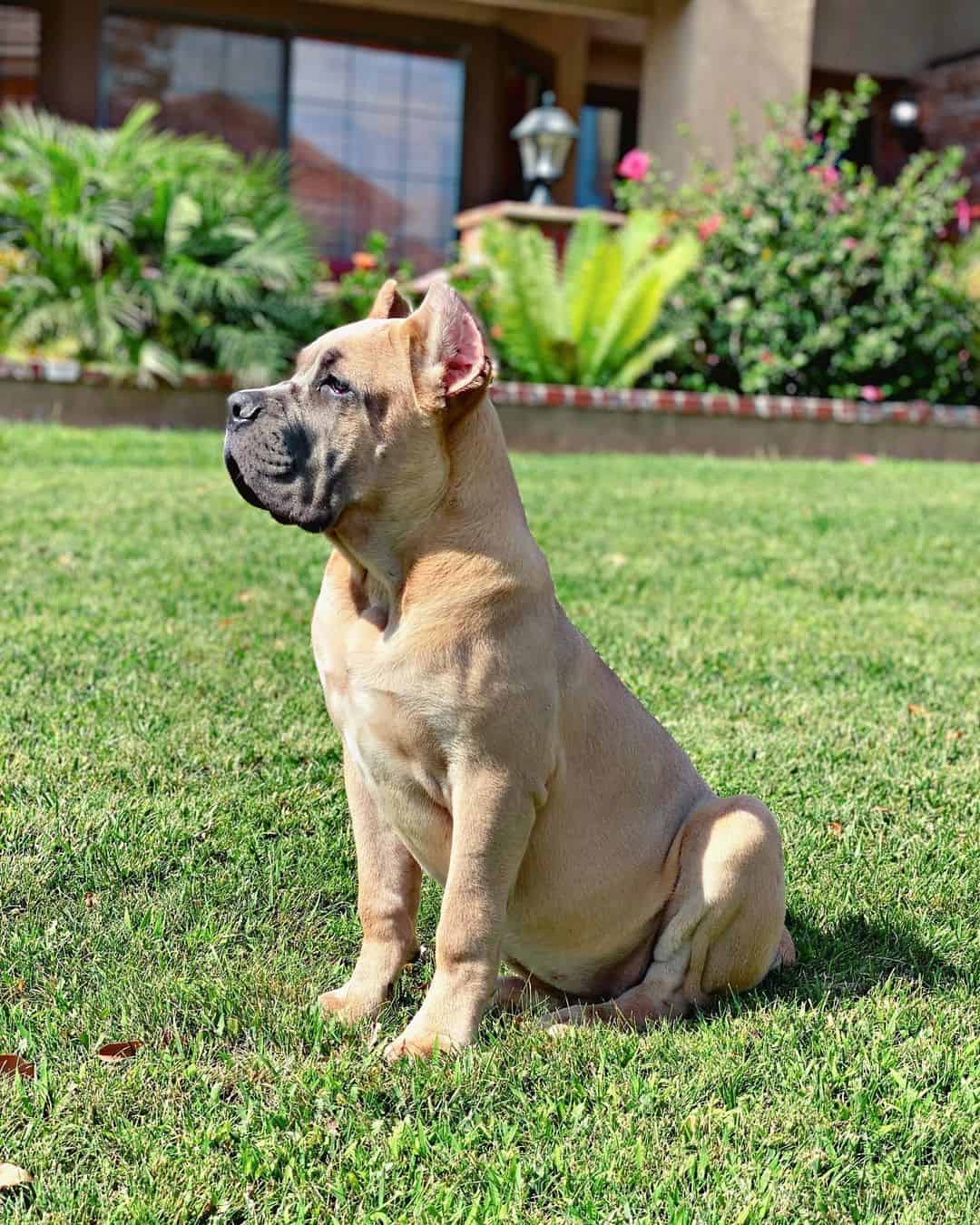
Photo from: @veleno_the_corso
To avoid disappointment, you should be aware that puppies often change color as they develop. There is a limit to this in that a gray pup won’t turn red or suddenly show the formentino color.
However, light colors can darken significantly, and brindle patterns become stronger.
If it’s a formentino Cane Corso puppy you’re after, you need to be patient! We’ll explain why further along, but first, here are some factors that may affect coat color:
• Nutrition
• Exposure to sunlight
• Skin complaints
• Medication
• Level of maturity
Being aware of these is part of being a responsible dog owner. It’s not just about the color of your pup; it’s about looking after its health and welfare.
Before you bring your formentino Cane Corso puppy home, you need to be prepared. This little bundle of fur won’t stay small for long, and you’ll soon have a very large, powerful, and energetic young dog on your hands! You’ll need to puppy-proof your home and yard, and as the dog grows, you must always ensure that your yard has a high, secure fence.
You must also be prepared financially for your puppy. Aside from the initial cost of buying the dog, you’ll need to set aside funds for a whole load of equipment such as collars, leashes, toys, beds, and so on. Then, you need to consider vet bills, which are generally more for bigger dogs. You also need to think about pet insurance*, grooming, training sessions, and dog walking/sitting.
Overall, the first year could cost around $4,500 in combined expenses. Following this, it will probably fall to around $2,000 per year.
*Some insurers won’t provide insurance for Cane Corsi. In fact, some companies won’t provide home insurance if they know you have one!
Formentino Cane Corso Breeders
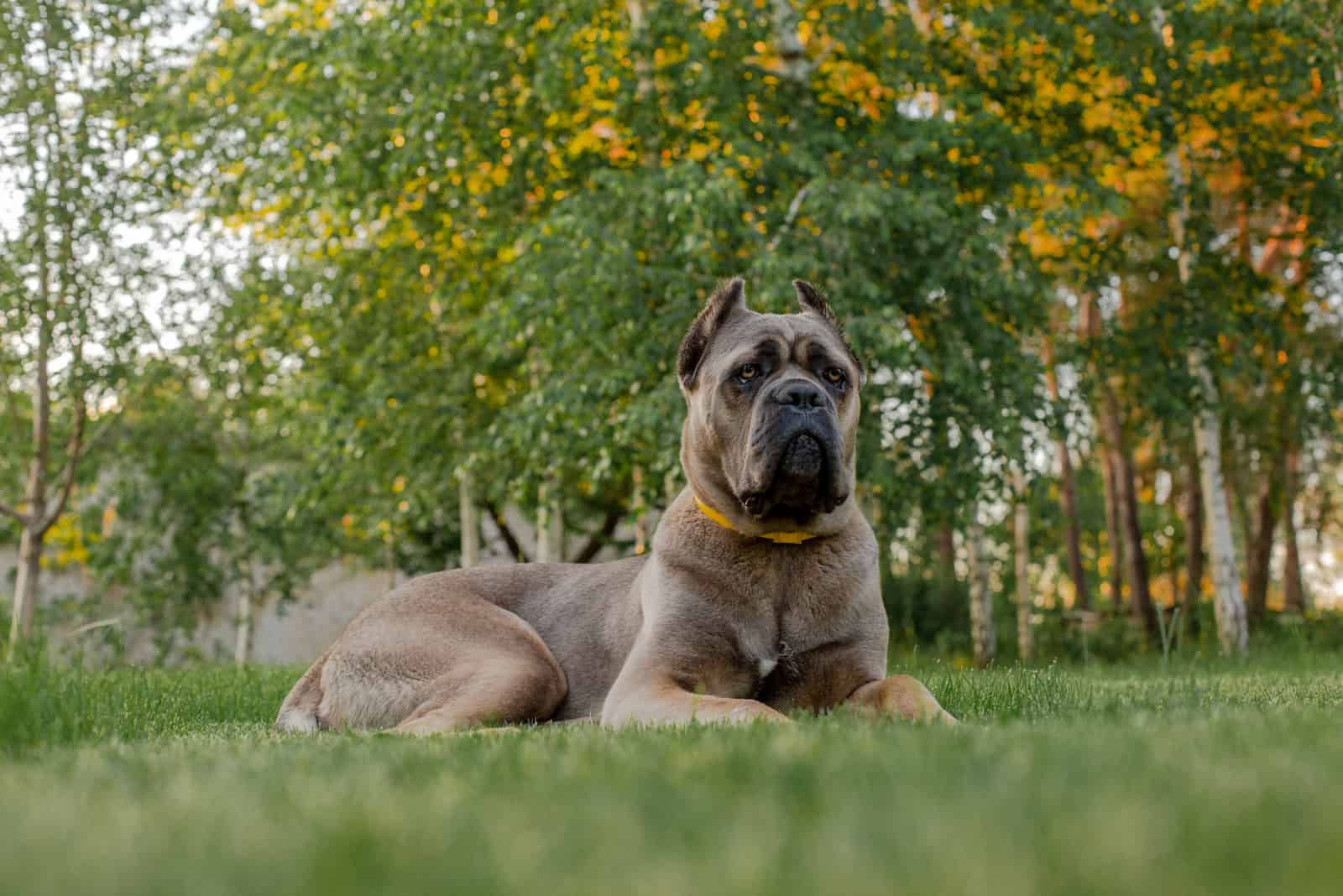
You won’t find a breeder that produces only formentino Cane Corso dogs.
Let’s put it another way: you won’t find a reputable, ethical breeder that does so! The color of the pups in each litter won’t be known until they are born. Breeders will have an idea as to what to expect, but they may be surprised when the pups are born.
For example, out of a litter of six pups, three of them may be black-brindle, two might have a gray coat, and one could be formentino. It all depends on the genes inherited from the parent dogs.
If you have your heart set on a formentino Cane Corso, first, find a breeder that you can trust. Speak to them to see what the chances are of getting the color you are after. It will then be a waiting game, but there are no guarantees that you’ll get the color you want.
You may need to wait for a while until your pup arrives.
Many breeders aren’t keen on producing colors outside of the breed standards as these are often regarded as faults in the breed. They believe that the genes carry health conditions that can be passed on to the pups.
Formentino Cane Corso Colors
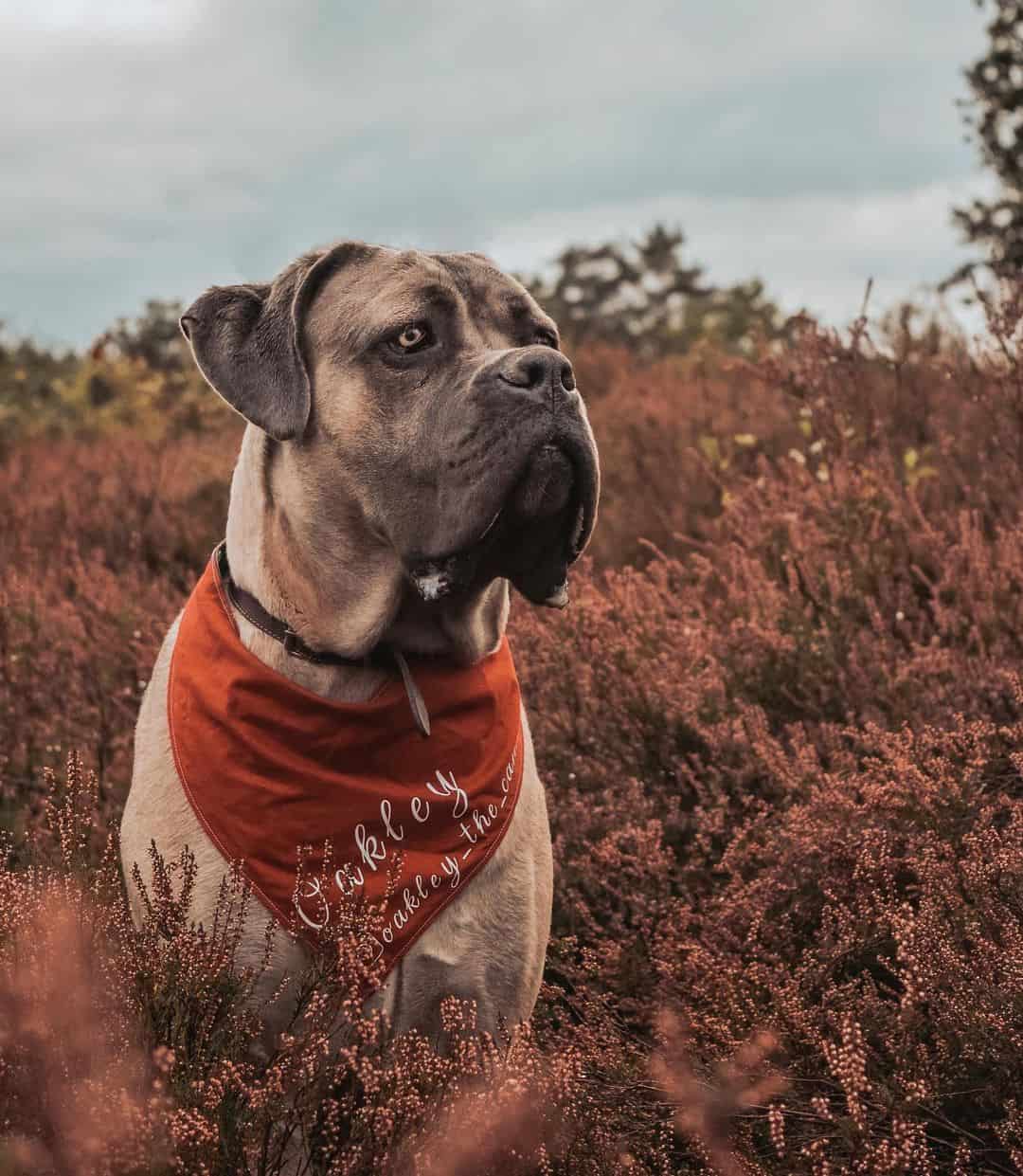
Photo from: @oakley_the_cane_corso
So, what other colors are there aside from the formentino and the classic all-black Cane Corso?
The AKC breed standard lists the following:
• Fawn
• Chestnut brindle
• Gray brindle
• Black brindle
• Red
These dogs can have either a black or a gray mask.
You probably have noticed that the formentino isn’t listed here as it is not accepted in the breed standard. However, a formentino Cane Corso shouldn’t be penalized or disqualified when entered in a show!
Black is often regarded as the standard color for the Cane Corso, partly as it looks so good, but also because it is the only Molosser breed to come in solid black.
Aside from the colors listed above, you can also get blue brindle, liver/chocolate, isabella/tawny, and straw.
When it comes to dog coat colors, there are two ways to explain them. The first way is to keep it as simple as possible, but there is a danger of oversimplifying things and leaving questions unanswered. The second way is to delve into genetics, alleles, loci, chromosomes, and DNA. You’ll see words like homozygous, and somatic mutations.
Now, if that’s the kind of explanation that makes you happy, then congratulations, Einstein, you’re a genius!
However, we’re sticking with the first way as it gives a basic outline of what’s going on that isn’t too taxing on our poor brains, and it makes this article more appealing and readable for everyone. It also allows you to do further research if you so desire.
So, basically, dogs get their colors from two pigments:
• Pheomelanin (yellow)
• Eumelanin (black)
Cells inside the hair follicles called melanocytes add these two types of melanin to the hair as it grows. The more melanin, the darker the color.
Now, bear in mind that every conceivable dog coat color is made up of these two pigments!
It all depends on the genes that the pup inherits from its parents. These will tell the melanocytes to switch on or off, controlling the color and tone. Darker colors can be diluted to create a range of reds, golds, blues, grays, and browns. They also provide the base color on which the brindle pattern is found.
Brindling occurs when the genes tell the melanocytes to switch from one color to another while the hair is growing, creating a striped pattern in the fur.
Some dogs lack melanin completely, resulting in white and albino examples (there is a difference! Not all white dogs are albinos).
Formentino Vs Fawn Cane Corso
The main difference between the two is that fawn can be used to describe anything from cream to tan!
Some dark fawn dogs have been mistaken for red Cane Corsi, but the breed standards state that red and fawn are completely separate colors.
One tip to help you identify a true fawn-colored Cane Corso is to look at its face. Fawn Cane Corsi have a gray or black mask that stops at their eyes. They may also have a white patch on their chest, chin, throat, and lower leg.
Blue Formentino Cane Corso
If you see anyone advertising a blue formentino Cane Corso, our best advice is to ignore it and move on! The seller is either trying to trick you or doesn’t have adequate breeding knowledge or experience.
First, there is no such thing as a blue formentino Cane Corso. It is either blue fawn or formentino. It might seem picky, but it’s important to get the names right so that everyone knows what’s what.
We’ll find out more about the enigmatic blue color in the next section.
Are Formentino Cane Corso Rare?
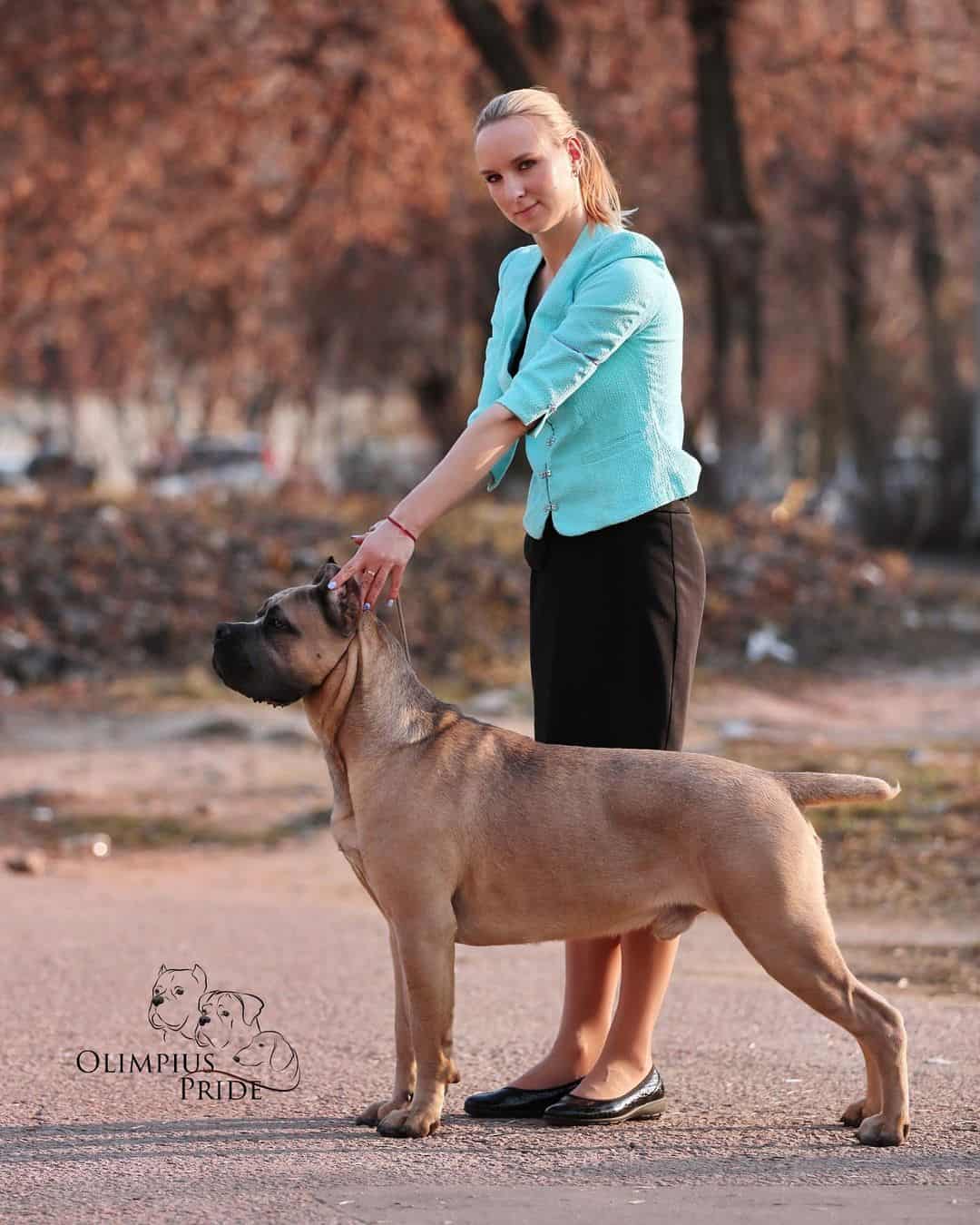
Photo from: @olimpius_pride
Yes, they are rarer than some other colors as it is the result of a recessive gene. However, there are other colors that are rarer still.
These include chocolate/liver, isabella/tawny, and straw. Out of these, the straw color is the rarest. It is thought that there is only one living example in America out of between 10 and 20 in the whole world! These dogs appear to be almost completely white, but it is really an extremely dilute fawn.
The trouble with some of these names for dog coat colors is that not everyone uses the same ones. Even the AKC and the FCI (Fédération Cynologique Internationale) breed standards for the Cane Corso have caused confusion by describing dilute black as gray rather than blue, which is the term often used by many breeders and dog lovers.
This has led some people to suggest that the blue Cane Corso doesn’t exist. In fact, it does, but it’s usually referred to as a gray Cane Corso!
Formentino Cane Corso: Health Problems
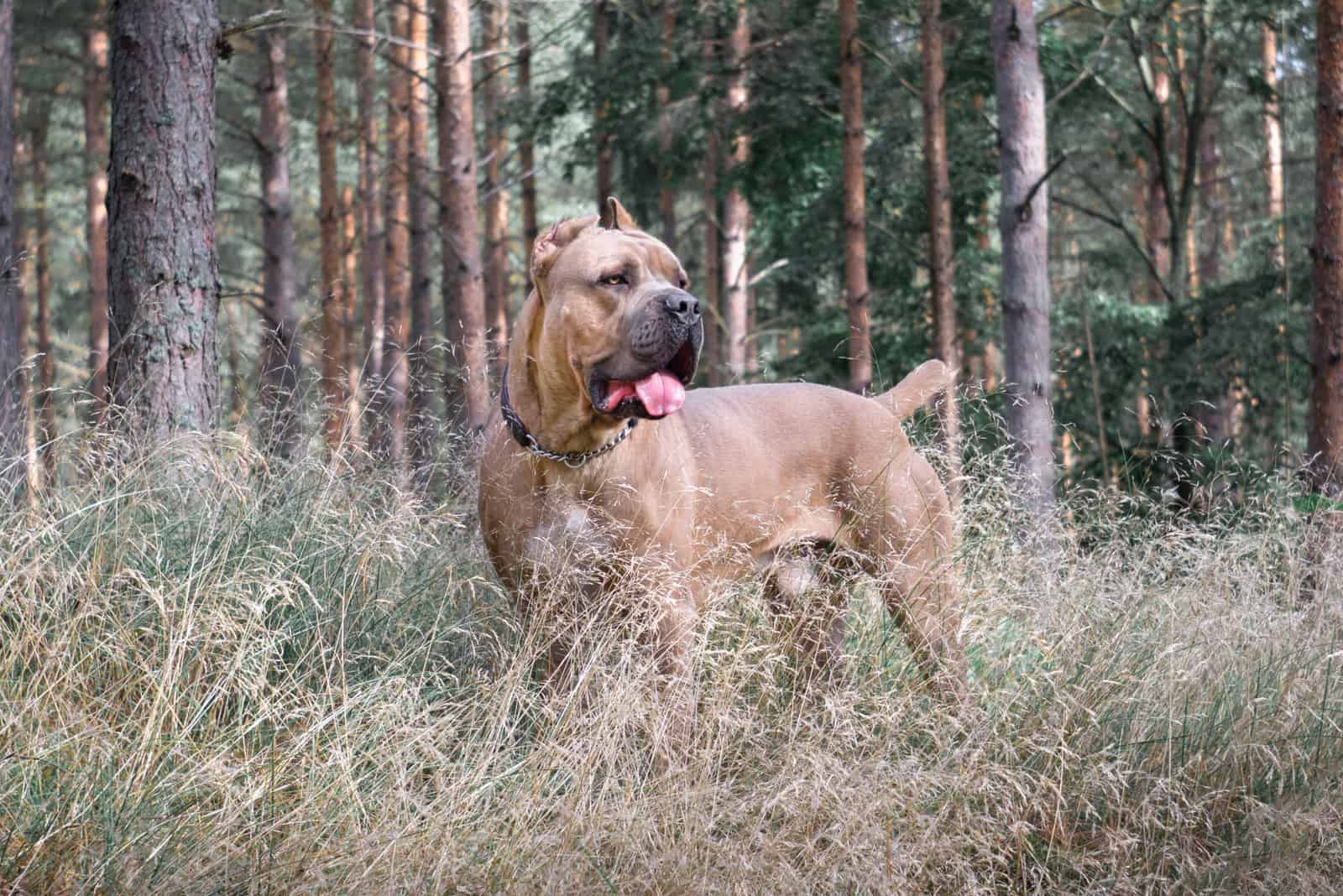
The Cane Corso breed is generally healthy, but there are some common health issues to be aware of:
• Elbow dysplasia – a poorly developed elbow joint that can cause arthritis.
• Hip dysplasia – similar to the above, but affecting the hip joint. Both conditions sometimes require surgery in severe cases, which is traumatic for the dog, and can be very expensive.
• Eye problems – such as cherry eye, entropion, and ectropion. The first condition is an inflammation of the third eyelid gland. The other two conditions relate to hairs on the eyelid scraping on the eyeball.
• Bloat – the medical name for this is gastric torsion or gastric dilatation-volvulus (GDV). The stomach inflates and twists around on itself, cutting off blood flow to vital organs. This mostly affects large dogs with deep chest cavities, and it can be fatal if not diagnosed and treated in time.
In addition to these, the formentino Cane Corso is more prone to skin allergies and conditions like mange.
Also, as mentioned previously, there is a strong possibility that these beautiful dogs don’t live as long as the brindle Cane Corso or their black counterparts. Once again, we would need to explore the subject of genetics to discover why this is, but one suggestion is that crossbreeding is responsible.
When the breed almost became extinct, some of the remaining Cane Corsi were bred with other Mastiffs to improve the bloodline, and this introduced fresh genes, creating the brindle dogs we know and love today. These brindle puppies formed a healthier line that has an increased lifespan.
This is something to keep in mind if you want to buy a formentino Cane Corso as it is not likely to live as long as the black or brindle dogs. Like it or not, it seems that the Cane Corso coat color might limit its lifespan.
A Few Last Words

Photo from: @sovereigncorsokenneluk
Without a doubt, the formentino Cane Corso is a beautiful-looking dog. Then again, these amazing creatures look great whatever color they are.
First and foremost, they are working dogs. They take their guard dog duties seriously, and will protect their home and family at any cost. They are also very big, measuring between 25 and 27.5 inches at the shoulder, sometimes more. They can weigh between 90 and 120 pounds. On top of this, they are incredibly athletic and powerful.
As such, they are not a dog for the faint-hearted, and definitely not for first-time dog owners. You need to have a commanding, assertive character and impress your authority on your pup from an early age. They will try to test this a few times, but you must persevere or else they will assume the role of pack leader.
Training and socialization are always important, but for the Cane Corso, it is doubly so. You don’t want a 120-pound dog that decides to do its own thing! You must be in charge all of the time.
The good news is that despite its stubborn nature, the Cane Corso wants to please you, and is very intelligent. Stick with it and you’ll have a well-adjusted, obedient friend that is utterly loyal to the end.
Take your time in finding the right breeder. Discuss any concern you have, and let them know the color you want. You may be in for a lengthy wait! But, if it’s really the dog that you want, then it’s worth the wait.
A good breeder will provide all the information you need, and will offer a lifetime of advice and support once you bring your pup home. There’s a good chance that you’ll need it, so be sure to take advantage of this!
Finally, you need to accept that big dogs tend to have shorter lives than small ones, and the formentino Cane Corso seems to be particularly affected because of its coat color. It doesn’t make this dog any less amazing; it just makes the time you spend together even more precious, so be sure to make the most of it and enjoy every moment.















